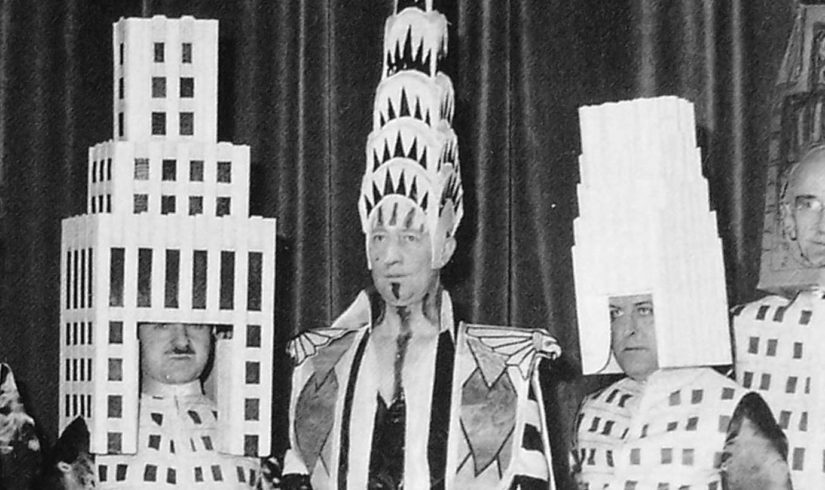
Ely Jacques Kahn
Also known as Ely Kahn
Noted architect Ely Jacques Kahn was president of the Municipal Art Society and was involved in the efforts to save Castle Clinton.
Ely Jacques Kahn the “master of the 1920s loft building,” was born in 1884. His father was a glass and mirror importer. He attended Columbia University as an undergraduate and later, in 1907, studied at the École des Beaux-Arts, alongside William Van Alen, the man who would design the Chrysler Building. In 1918, he assumed partnership in the architecture firm of Buchman and Fox, which later became Buchman and Kahn. His firm specialized in loft and retail construction. Its projects included the full block of elegant marble facades on Fifth Avenue from 57th to 58th Streets, built in 1927, which were later combined to form Bergdorf Goodman.1
Kahn was successful commercially, and he managed to file plans for four-dozen large buildings in New York City alone between 1925 and 1930. He strategically partnered with developers like Louis Adler and Abe N. Adelson, and sought companies that would pay high prices for aesthetics.2 He built his reputation in the 1920s based upon his use of color. His design for 2 Park Avenue at 33rd Street, which utilized glazed terra cotta, marked his innovation. Kahn also designed the 1930 Squibb Building at Grand Army Plaza, located at 745 Fifth Avenue at 58th Street. The structure boasted an entirely white façade, as requested by Abe N. Adelson, who commissioned the project. The white exterior served to harmonize this building with the surrounding structures.3 In an article that Kahn wrote for the May 5, 1925 issue of The New York Times, he described his design philosophy. He lauded “a new style of architecture — a New York style.” In contrast, he rejected the “cluttered detail of the past” and promoted “forms allied to the rigid and powerful block of the building itself; shapes that are more a series of planes that become attractive through the play of light and shadow.”4 His abstract, geometric style reflected his classical training.
Though Kahn’s firm shrank during the Great Depression, he continued designing until 1965, and his firm, by then renamed Kahn & Jacobs, continued well after that. However, Kahn never recovered the clarity of vision that he demonstrated in the 1920s. He died in 1972. Later that year, his firm merged with Hellmuth, Obata & Kassabaum, which dropped the name Kahn & Jacobs in 1977. In April of 2006, the New York City Landmarks Preservation Commission designated landmark status to Kahn’s 1928 creation, 2 Park Avenue, in order to highlight the architect’s unique contributions. His son was Ely Jacques Kahn Jr., the noted writer for the New Yorker.5
Municipal Art Society
President, 1941
Program Committee of the Congress
Chairman, 1941
In May of 1941, the American Scenic and Historic Preservation Society and the New-York Historical Society jointly called a public meeting to discuss Robert Moses's impending plan to demolish the historic Castle Clinton, the Schenck House in Highland Park, and other historic properties that were owned by the City of New York and under the control of the Parks Department. The result of the meeting was the creation of a committee, intended to "ensure immediate and effective protest should any landmark be threatened, and to organize cooperative efforts for its preservation." Ely Jacques Kahn served as a member on this committee, along with Albert Bard, George McAneny, and Gardner Osborn.6
Subsequently, in 1941, when the newly elected president of the Municipal Art Society, Ralph Walker, had to resign from his post due to wartime defense work, Ely Jacques Kahn was chosen to succeed him. Under Kahn's leadership, the Society began to address the larger question of the preservation of the City's historic places.7 Kahn sought professional advice in order to discern the best way to address the topic. He consulted I. N. Phelps Stokes, the architect and historian, who wrote The Iconography of Manhattan. Stokes urged, "the study of the city’s historic sites and buildings be carried out under the guidance of experienced and technical leadership." Heeding Stokes' advice, Kahn opted to appoint a Society committee to protect and preserve such buildings from the increased threat to historically and architecturally significant buildings.8 This committee enlisted the help of Talbot F. Hamlin, then the Librarian of the Avery Architectural Library, to compile a list that was intended to catalog historically and architecturally significant buildings and to build public awareness of the need to preserve them.9
- Ely Jacques Kahn Drawings & Archives
Avery Architectural & Fine Arts Library
Columbia University
1172 Amsterdam Avenue
New York, NY 10027
Tel: (212) 854-4110
Email: avery-drawings@libraries.cul.edu
Municipal Art Society Minutes are located at the Archives of American Art. To contact reference services: Tel: (202) 633-7950 Fax: (202) 633-7994
- Christopher Gray, “A Master of the Loft Building Gets his Day in the Spotlight,” The New York Times, 27 August 2006.
- Ibid.
- Christopher Gray, “Streetscapes: The Old Squibb Building; ‘Restoration is Adding Color to Original All-White Design,” The New York Times, 2 October 1988.
- Christopher Gray, “A Master of the Loft Building Gets his Day in the Spotlight,” The New York Times, 27 August 2006.
- Ibid.
- Anthony C. Wood, Preserving New York: Winning the Right to Protect A City’s Landmarks (New York: Routledge, 2008), page 62.
- Ibid, page 63.
- Ibid, page 65.
- Ibid, page 116-117.


